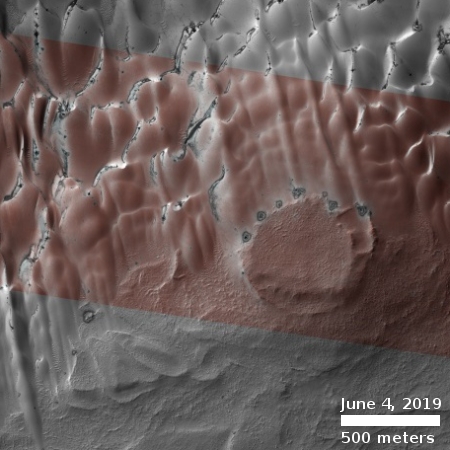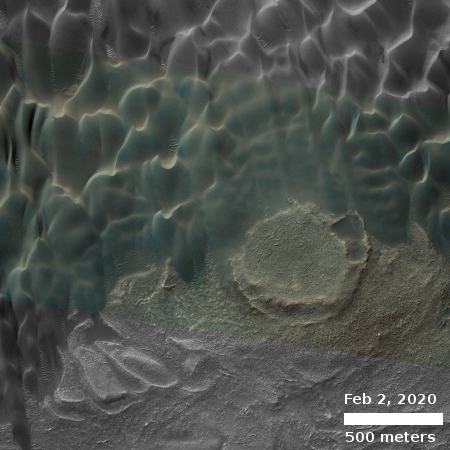Summer at the Martian North Pole

Cool image time! The image above, cropped, reduced, and brighten-enhanced to post here, was taken by the high resolution camera of Mars Reconnaissance Orbiter (MRO) on December 26, 2019 of the dunes just below the 1,500 to 3,000 foot high scarp that marks the edge of the Martian north polar icecap. I have brought up the brightness of the dune area to bring out the details.
This one image shows a range a very active features at the Martian north pole. At this scarp scientists have routinely photographed avalanches every Martian spring, as they have been occurring, caused by the warmth of sunlight hitting this cliff wall and causing large sections to break off. As Shane Byrne of the Lunar and Planetary Lab University of Arizona explained in my September 2019 article,
On Mars half of the images we take in the right season contain an avalanche. There’s one image that has four avalanches going off simultaneously at different parts of the scarp. There must be hundreds to thousands of these events each day.
On the left side of the image is an area of dunes that Candice Hansen of the Planetary Science Institute in Arizona has dubbed “Buzzell.” As spring arrives here, she has MRO regularly take images of this site (as well as about a dozen others) to monitor the changes that occur with the arrival of sunlight on the vast dune seas that surround that polar icecap.
The image to the right zooms in on one particular distinct feature, a pedestal crater, surrounded by dunes, that I have labeled on the image above. This image was taken just as spring began, with the Sun only five degrees above the horizon. At that time the dunes and pedestal crater were mantled by a frozen layer of translucent carbon dioxide that had fallen as dry ice snow during the sunless winter and then sublimates away each Martian summer.
Since March I have periodically posted updates to monitor the disappearance of that CO2 layer. (See for example the posts on August 2019 and November 2019.) Below are two more images, showing the ongoing changes to this area from early to late summer.
The June 4, 2019 image to the right was taken in early summer, with the Sun 20 degrees above the horizon and rising higher each day. The dark splotches are weak spots in the translucent CO2 layer where it first begins to break apart, spouting dust from below that tarnishes the layer around it.
The streaks pointing away from the pedestal crater are produced by windblown dust, and show us the direction of the prevailing winds at this location.
The bottom image to the right was taken on February 2, 2020 during late summer. The Sun is once again 20 degrees above the horizon, but now it is slowly getting closer to to the horizon each day. The dry ice layer is now entirely gone, causing the dark splotches to vanish because the dust now blends into the surrounding dune terrain. As Hansen explained in an email to me today,
We are seeing the dark basaltic sand that the dunes are made of. Think Hawaii with its black sand beaches!
At the pedestal crater however we are likely looking at bedrock, a high point where all the Martian dust has blown away. However, in only a few months autumn and winter will arrive, the Sun will disappear, and this bedrock will once again be covered by a mantle of dry ice snow.
During avalanche season in the spring and early summer however I imagine that someday there will be an enclosed glass-walled observation point on top of this pedestal crater, where tourists from the southern Martian cities will come to watch the many daily avalanches coming off that scarp, less than four miles away.
On Christmas Eve 1968 three Americans became the first humans to visit another world. What they did to celebrate was unexpected and profound, and will be remembered throughout all human history. Genesis: the Story of Apollo 8, Robert Zimmerman's classic history of humanity's first journey to another world, tells that story, and it is now available as both an ebook and an audiobook, both with a foreword by Valerie Anders and a new introduction by Robert Zimmerman.
The print edition can be purchased at Amazon or from any other book seller. If you want an autographed copy the price is $60 for the hardback and $45 for the paperback, plus $8 shipping for each. Go here for purchasing details. The ebook is available everywhere for $5.99 (before discount) at amazon, or direct from my ebook publisher, ebookit. If you buy it from ebookit you don't support the big tech companies and the author gets a bigger cut much sooner.
The audiobook is also available at all these vendors, and is also free with a 30-day trial membership to Audible.
"Not simply about one mission, [Genesis] is also the history of America's quest for the moon... Zimmerman has done a masterful job of tying disparate events together into a solid account of one of America's greatest human triumphs."--San Antonio Express-News

Cool image time! The image above, cropped, reduced, and brighten-enhanced to post here, was taken by the high resolution camera of Mars Reconnaissance Orbiter (MRO) on December 26, 2019 of the dunes just below the 1,500 to 3,000 foot high scarp that marks the edge of the Martian north polar icecap. I have brought up the brightness of the dune area to bring out the details.
This one image shows a range a very active features at the Martian north pole. At this scarp scientists have routinely photographed avalanches every Martian spring, as they have been occurring, caused by the warmth of sunlight hitting this cliff wall and causing large sections to break off. As Shane Byrne of the Lunar and Planetary Lab University of Arizona explained in my September 2019 article,
On Mars half of the images we take in the right season contain an avalanche. There’s one image that has four avalanches going off simultaneously at different parts of the scarp. There must be hundreds to thousands of these events each day.
On the left side of the image is an area of dunes that Candice Hansen of the Planetary Science Institute in Arizona has dubbed “Buzzell.” As spring arrives here, she has MRO regularly take images of this site (as well as about a dozen others) to monitor the changes that occur with the arrival of sunlight on the vast dune seas that surround that polar icecap.
The image to the right zooms in on one particular distinct feature, a pedestal crater, surrounded by dunes, that I have labeled on the image above. This image was taken just as spring began, with the Sun only five degrees above the horizon. At that time the dunes and pedestal crater were mantled by a frozen layer of translucent carbon dioxide that had fallen as dry ice snow during the sunless winter and then sublimates away each Martian summer.
Since March I have periodically posted updates to monitor the disappearance of that CO2 layer. (See for example the posts on August 2019 and November 2019.) Below are two more images, showing the ongoing changes to this area from early to late summer.
The June 4, 2019 image to the right was taken in early summer, with the Sun 20 degrees above the horizon and rising higher each day. The dark splotches are weak spots in the translucent CO2 layer where it first begins to break apart, spouting dust from below that tarnishes the layer around it.
The streaks pointing away from the pedestal crater are produced by windblown dust, and show us the direction of the prevailing winds at this location.
The bottom image to the right was taken on February 2, 2020 during late summer. The Sun is once again 20 degrees above the horizon, but now it is slowly getting closer to to the horizon each day. The dry ice layer is now entirely gone, causing the dark splotches to vanish because the dust now blends into the surrounding dune terrain. As Hansen explained in an email to me today,
We are seeing the dark basaltic sand that the dunes are made of. Think Hawaii with its black sand beaches!
At the pedestal crater however we are likely looking at bedrock, a high point where all the Martian dust has blown away. However, in only a few months autumn and winter will arrive, the Sun will disappear, and this bedrock will once again be covered by a mantle of dry ice snow.
During avalanche season in the spring and early summer however I imagine that someday there will be an enclosed glass-walled observation point on top of this pedestal crater, where tourists from the southern Martian cities will come to watch the many daily avalanches coming off that scarp, less than four miles away.
On Christmas Eve 1968 three Americans became the first humans to visit another world. What they did to celebrate was unexpected and profound, and will be remembered throughout all human history. Genesis: the Story of Apollo 8, Robert Zimmerman's classic history of humanity's first journey to another world, tells that story, and it is now available as both an ebook and an audiobook, both with a foreword by Valerie Anders and a new introduction by Robert Zimmerman.
The print edition can be purchased at Amazon or from any other book seller. If you want an autographed copy the price is $60 for the hardback and $45 for the paperback, plus $8 shipping for each. Go here for purchasing details. The ebook is available everywhere for $5.99 (before discount) at amazon, or direct from my ebook publisher, ebookit. If you buy it from ebookit you don't support the big tech companies and the author gets a bigger cut much sooner.
The audiobook is also available at all these vendors, and is also free with a 30-day trial membership to Audible.
"Not simply about one mission, [Genesis] is also the history of America's quest for the moon... Zimmerman has done a masterful job of tying disparate events together into a solid account of one of America's greatest human triumphs."--San Antonio Express-News





Is the Mars Reconnaissance Orbiter the hardest working craft in show biz? It’s fascinating to watch another planet change in (close to) real time.
“Pre-emptive Rail-Gun attack on the Martian Orbital weapon platforms”
The Expanse 2018
https://youtu.be/9fgaMhcTxCY
5:05